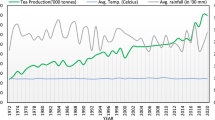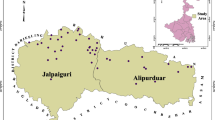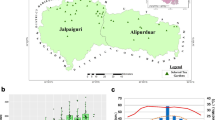Abstract
The plantation crop sector, particularly tea, is a key contributor to the Sri Lankan economy in terms of foreign exchange earnings, employment, and food supply. However, changes in temperature, rainfall, and the occurrence of extreme weather events have adversely affected the sector. Many studies in the literature have focused on climate change impacts on major annual crops; however, to date, comprehensive assessments of the economic impacts of weather variations on perennial crops are rare. In this paper, we use monthly panel data from 40 different tea estates in Sri Lanka over a 15-year period to analyse weather effects on production from the tea plantation sector. Specifically, we use a two-stage panel data approach to explore how tea production in Sri Lanka is affected by both short-term weather variations and long-term climate change. Overall, our findings show that a hotter and wetter climate will have a detrimental effect on Sri Lankan tea production. In high, medium, and low emissions futures, our predictions show a negative proportional impact from increased rainfall and increased average temperature. Under a high emissions scenario, by mid-century, a decline of 12% in annual tea production is predicted. Other climate-susceptible perennial crops such as rubber, coconut, and oil palm play similarly major roles in the economies of other developing countries, suggesting that our approach could usefully be replicated elsewhere.

Similar content being viewed by others
Notes
It is important to note the distinction between weather and climate. Throughout this paper, ‘weather’ refers to localized temperature and rainfall at a given time, whereas ‘climate’ refers to weather averaged over long periods of time (i.e. 15 years).
Low-country tea plantations are located between sea level and 300 m elevation, mid-country plantations between 300–900 m, and up-country plantations at elevations above 900 m.
Agro-ecological regions (AER) are categorized based on rainfall, elevation and soil type. Sri Lanka comprises 46 AERs, of which 22 contain tea estates.
We acknowledge the suggestions generously provided by Prof. Jeffrey Vincent here.
Linear regression models were an early approach for exploring links between climate and agricultural outputs, but are now little used because of significant limitations associated with the assumption that yield responds linearly to climate.
Mendelsohn’s Ricardian approach would not be appropriate for tea production in the plantation sector in Sri Lanka, because the Government retains ownership of the underlying land, so there is no competitive land market. Further, opportunities for crop switching on tea estates are extremely limited, given long term investments in perennial plantings.
A lag period up to two months was used for fertiliser in accordance with advice from agronomists in Sri Lanka (Wijeratne: personnel communication—February 5, 2016).
We initially included agro-chemicals as an input variable, but it was not found to exert a significant impact on yield. This was subsequently confirmed by Sri Lankan tea agronomists.
Tea shoot growth depends on both intensity and distribution of rainfall. Approximately 6–7 days of rainfall per month are required for ideal growth.
Phenological development of tea shoot usually takes 45–60 days, depending on elevation and other bio-physical factors.
Area harvested is largely fixed in the short-run because tea is a perennial crop; it can therefore be considered exogenous.
Planting materials obtained from asexual methods. Yield of vegetatively-propagated tea is higher than seedling tea.
Current, lag-1 and lag-2 variables in fertiliser were included to account for the time lag between application and effect.
We constructed different long-term weather variables to characterize monsoonal effects in the second-stage model, but unfortunately very high VIFs between weather variables from Sri Lanka’s two monsoonal seasons prevented these variables from being used.
Complete monthly records over the 15 years 2000–2014 (i.e., 180 data points per estate) were available for 28 estates, slightly shorter data sequences were obtained from some estates for which earlier records had been damaged or destroyed. Estate record keeping seems to be well organized and all expenditure items related to field and factory operations are neatly recorded in monthly accounts. The estate offices prepare this record monthly and send these to the head office of their plantation company for observation and verification. Annual external auditing of accounts is mandatory for all estates. These records are therefore believed to be accurate. We collected the data by digitally photographing estate record books and then transcribed relevant data manually.
Given the mountainous topography of tea growing areas in Sri Lanka, weather changes rapidly between locations. For interpolation, we therefore, chose climate grid points within a 40km radius of each estate and weather station.
We ran the different specifications with the same variables as Model 4 in Table 1. Following the method of Wooldridge (2013) pages 212–214, we found the adjusted R 2 for log-log and semi-log specifications to be 0.73 and 0.70, respectively, compared to 0.58 for the linear model. We also estimated a quadratic specification, but most of the parameters were not significant.
Estimating the impact of fertiliser on production proved difficult because monthly data detailed expenditure on fertiliser rather than quantity applied.
Vegetative propagation (VP) technology was introduced to Sri Lanka in the 1950s and subsequent replantings have used this technology because it delivers higher yields. However, replanting with VP has proceeded less rapidly in the estate sector than the smallholding sector because of the high capital investment requirement. Currently, around 50% of the total tea area in the estate sector is VP tea while around 90% of the total smallholding area is VP. This is one of the key reasons for the high productivity of smallholder sector.
We do not have predictions of the number of wet days per month under future climate scenarios, so we cannot include the long-term impact of wet days per month in our production projections.
Wijeratne et al. used production data from 1975–1995, we used production data from 2000–2014; Wijeratne et al. used separate sole-driver regressions to identify weather effects, whereas we used our two-stage panel data multi-regressor approach.
References
ADB (1994) Climate change in Asia: Sri Lanka Country Report. Asian Development Bank, Colombo
Ahmed M, Suphachalasai S (2014) Assessing the costs of climate change and adaptation in South Asia. Asian Development Bank, Mandaluyong City
Amarathunga MKSLD, Wijeratne MA (2009) Effect of variation of some of the ecological factors on sustainable productivity of clonal tea. J Natl Sci Found Sri Lanka 23:28–35
Arellano M (1987) Computing robust standard errors for within‐groups estimators. Oxf Bull Econ Stat 49:431–434
Ashenfelter O, Storchmann K (2010) Measuring the economic effect of global warming on viticulture using auction, retail, and wholesale prices. Rev Ind Organ 37(1):51–64
Auffhammer M, Ramanathan V, Vincent JR (2012) Climate change, the monsoon, and rice yield in India. Clim Chang 111:411–424. doi:10.1007/s10584-011-0208-4
Boehm R et al (2016) Association between empirically estimated monsoon dynamics and other weather factors and historical tea yields in China: results from a yield response model. Climate 4:20
Carr MKV (1972) The climatic requirements of the tea plant: a review. Exp Agric 8:1–14
Central Bank of Sri Lanka (1992) Annual report. Central Bank of Sri Lanka, Colombo
Central Bank of Sri Lanka (2009) Annual report. Central Bank of Sri Lanka, Colombo
Central Bank of Sri Lanka (2013) Annual report. Central Bank of Sri Lanka, Colombo
Central Bank of Sri Lanka (2014) Annual report. Central Bank of Sri Lanka, Colombo
Costa WAJMD, Mohotti AJ, Wijeratne MA (2007) Ecophysiology of tea. Braz J Plant Physiol 19:299–332
De Costa W (2010) Adaptation of agricultural crop production to climate change: a policy framework for Sri Lanka. J Natl Sci Found Sri Lanka 38:79–89
Deschenes O, Greenstone M (2007) The economic impacts of climate change: evidence from agricultural output and random fluctuations in weather. Am Econ Rev 97:354–385. doi:10.1257/aer.97.1.354
Deschenes O, Kolstad C (2011) Economic impacts of climate change on California agriculture. Clim Chang 109:365–386. doi:10.1007/s10584-011-0322-3
FAO (2014) Report of working group on climate change. Food and Agriculture Organization, Intersessional Meeting of Intergovernmental Group on Tea
Ganewatta G, Waschik R, Jayasuriya S, Edwards G (2005) Moving up the processing ladder in primary product exports: Sri Lanka’s "value-added" tea industry. Agric Econ 33:341–350. doi:10.1111/j.1574-0864.2005.00073.x
Guiteras R (2009) The impact of climate change on Indian agriculture. Unpublished
Hansen L (1991) Farmer response to changes in climate: the case of corn production. J Agr Econ Res 43:18–25
Hausman JA (1978) Specification tests in econometrics. Econometrica 1251-1271
Herath D, Weersink A (2009) From plantations to smallholder production: the role of policy in the reorganization of the sri lankan tea sector. World Dev 37:1759–1772. doi:10.1016/j.worlddev.2008.08.028
Illukpitiya P, Shanmugaratnam N, Kjosavik DJ (2004) Tea agroecosystems in the Uva Highlands of Sri Lanka. Mt Res Dev 24:52–59. doi:10.1659/0276-4741(2004)024[0052:TAITUH]2.0.CO;2
IPCC Special Report Emissions Scenarios: IPCC Fourth Assessment Report (AR4) (2007) https://www.ipcc.ch/pdf/special-reports/spm/sres-en.pdf. Accessed 30 April 2016
Kaufmann RK, Snell SE (1997) A biophysical model of corn yield: integrating climatic and social determinants. Am J Agr Econ 79(1):178–190
Kelly DL, Kolstad CD, Mitchell GT (2005) Adjustment costs from environmental change. J Environ Econ Manag 50:468–495. doi:10.1016/j.jeem.2005.02.003
Lobell DB, Cahill KN, Field CB (2007) Historical effects of temperature and precipitation on California crop yields. Clim Chang 81:187–203. doi:10.1007/s10584-006-9141-3
Mendelsohn R, Nordhaus WD, Shaw D (1994) The impact of global warming on agriculture—a Ricardian analysis. Am Econ Rev 84:753–771
Schlenker W, Lobell DB (2010) Robust negative impacts of climate change on African agriculture. Environ Res Lett 5:014010. doi:10.1088/1748-9326/5/1/014010
Seo SNN, Mendelsohn R, Munasinghe M (2005) Climate change and agriculture in Sri Lanka: a Ricardian valuation. Environ Dev Econ 10:581–596. doi:10.1017/s1355770x05002044
Upadhyaya H, Panda SK (2004) Responses of Camellia sinensis to drought and rehydration. Biol Plant 48:597–600. doi:10.1023/b:biop.0000047158.53482.37
Welch JR, Vincent JR, Auffhammer M, Moya PF, Dobermann A, Dawe D (2010) Rice yields in tropical/subtropical Asia exhibit large but opposing sensitivities to minimum and maximum temperatures. Proc Natl Acad Sci U S A 107:14562–14567. doi:10.1073/pnas.1001222107
Wijeratne MA (1996) Vulnerability of Sri Lanka tea production to global climate change. Water Air Soil Pollut 92:87–94
Wijeratne MA, Anandacoomaraswamy A, Amarathunga MKSLD, Ratnasiri J, Basnayake BRSB, Kalra N (2007) Assessment of impact of climate change on productivity of tea (Camellia sinensis L.) plantations in Sri Lanka. J Natl Sci Found Sri Lanka 35:119–126
Wijeratne MA, Chandrapala L. Climatic variations in tea growing regions and vulnerability of tea plantations to climate change. In: 228th meeting of the experiment and extension forum, Tea Research Institute of Sri Lanka January 31, 2014.
Wooldridge J (2013) Introductory econometrics: a modern approach, 5th edn. Nelson Education, USA
Acknowledgements
This work would not have been possible without permission from Sri Lankan tea plantation companies to access their records. The assistance from Mr Niraj De Mel is greatly appreciated in this regard. We gratefully acknowledge helpful comments from Dr Celine Nauges and Prof. Jeffrey Vincent. The RIMES supported by giving the access for the downscaled prediction data. The authors also thank Ms Chithrangani Rathnayake, Dr Senani Karunaratne, and Mr Graeme Curwen for their assistance in GIS. The financial support given by the Australia Endeavour Postgraduate Research Scholarship and South Asian Network for Development and Environmental Economics is greatly appreciated.
Author information
Authors and Affiliations
Corresponding author
Electronic supplementary material
Below is the link to the electronic supplementary material.
ESM 1
(PDF 157 kb)
Rights and permissions
About this article
Cite this article
Gunathilaka, R.P.D., Smart, J.C.R. & Fleming, C.M. The impact of changing climate on perennial crops: the case of tea production in Sri Lanka. Climatic Change 140, 577–592 (2017). https://doi.org/10.1007/s10584-016-1882-z
Received:
Accepted:
Published:
Issue Date:
DOI: https://doi.org/10.1007/s10584-016-1882-z




